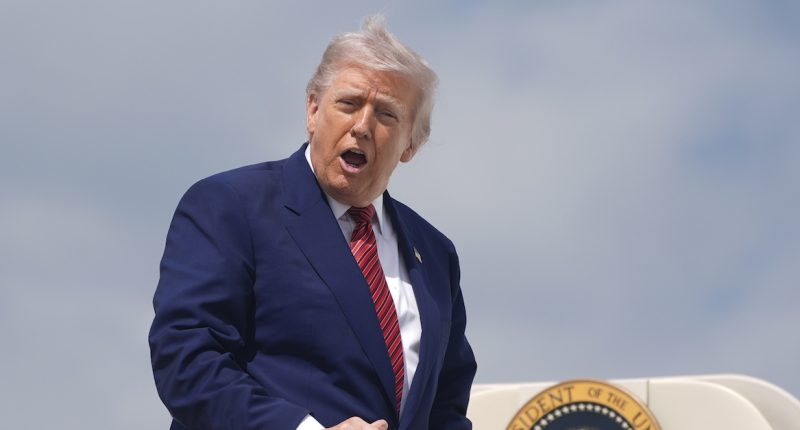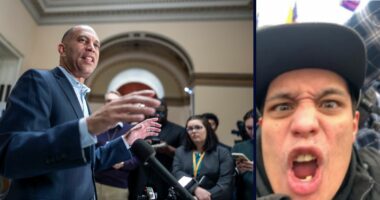Share this @internewscast.com
President Donald Trump boards Air Force One to depart Joint Base Andrews, Md., Friday, May 23, 2025 (AP Photo/Manuel Balce Ceneta).
On Friday, the Trump administration urged the U.S. Supreme Court to overturn a lower court order that prevents the Department of Education (DOE) from implementing widespread staff dismissals and transferring various programs, such as student loan portfolios, to other agencies.
In a 40-page application for a stay, Solicitor General D. John Sauer, representing the U.S. Department of Justice, argued that the lower court did not have the authority to issue the preliminary injunction in the current case. This aligns with the second Trump administration’s ongoing stance against the concept of national injunctive relief.
“For the second time in three months, the same district court has obstructed the Executive Branch’s capacity to manage the Department of Education, despite not having jurisdiction over the Executive’s internal management decisions,” the application states. “This Court previously limited that overreach when the district court sought to stop the Department from ending discretionary grants. Now, the district court is trying to block the Department from reorganizing its workforce, without proper jurisdiction again. Intervention is needed once more.”
The underlying litigation is a combination of two cases, one lawsuit filed by the state of New York and another lawsuit filed by several school districts and labor unions, docketed in March against the DOE over a planned “reduction-in-force” (RIF) that aimed to cut the agency’s staff by 50 percent. The lawsuits also take issue with plans to transfer the Federal Student Aid (FSA) and Individuals with Disabilities Education Act (IDEA) programs to other agencies — which the plaintiffs say is not allowed under the laws creating the programs.
Love true crime? Sign up for our newsletter, The Law&Crime Docket, to get the latest real-life crime stories delivered right to your inbox.
In late May, U.S. District Judge Myong Joun, a Joe Biden appointee, issued a preliminary injunction barring the government from carrying out the RIF, ordered the reinstatement of all DOE employees terminated since President Donald Trump’s inauguration, and prohibited the DOE from transferring the FSA and IDEA programs.
“This case arises out of an attempt by Defendants to shut down the Department without Congressional approval,” Joun wrote in the 88-page memorandum and order. “President Trump has publicly and repeatedly promised to shut down the Department ‘immediately.””
Now, the Trump administration is defending the proposed firing of 1,378 DOE employees as an allowable function of executive power in line with Trump’s political priorities — and disputing that such layoffs are part of a plan to shut down the agency.
“That RIF effectuates the Administration’s policy of streamlining the Department and eliminating discretionary functions that, in the Administration’s view, are better left to the States,” the application reads. “The government has been crystal clear in acknowledging that only Congress can eliminate the Department of Education. And the government has acknowledged the need to retain sufficient staff to continue fulfilling statutorily mandated functions and has kept the personnel that, in its judgment, are necessary for those tasks. The challenged RIF is fully consistent with that approach.”
The injunction in the case was issued on May 22. The government immediately applied for a motion to stay the injunction with the lower court itself — which Joun denied the very next day.
The DOJ also immediately appealed to the U.S. Court of Appeals for the First Circuit — which was denied by the three-judge appellate panel on Wednesday in a unanimous 26-page opinion.
“What is at stake in this case, the District Court found, was whether a nearly half-century-old cabinet department would be permitted to carry out its statutorily assigned functions or prevented from doing so by a mass termination of employees aimed at implementing the effective closure of that department,” the appeals court opined. “Given the extensive findings made by the District Court and the absence of any contrary evidence having been submitted by the appellants, we conclude that the appellants’ stay motion does not warrant our interfering with the ordinary course of appellate adjudication in the face of what the record indicates would be the apparent consequences of our doing so.”
But, to hear Sauer tell it, the DOE “remains committed to implementing its statutorily mandated functions.”
The real issue, the DOJ insists, is the improper injunction granted to an improper group of plaintiffs in the first place.
“That preliminary injunction epitomizes many of the same errors in recent district-court injunctions usurping control of the federal workforce,” the application goes on. “Article III limits federal courts to deciding concrete cases and controversies, not adjudicating abstract policy disagreements disconnected from the relief sought. Here, respondents — who are not Department employees, but end-users of government services — asserted standing based on the theory that the reduction in the Department’s workforce might affect the quality or promptness of Department services.”
In making their case to the justices, the Trump administration is pinning a large part of its argument on an analytical framework widely understood by legal scholars as “conservative standing doctrine.”
This judicial theory was created in two cases from the 1920s by conservative judges who sought to restrain the use and limits of constitutional redress. In other words, standing doctrine was created — and has over time been honed and sustained — to limit lawsuits against the government. While technically procedural in nature, as opposed to relying on the underlying merits arguments in a dispute, standing arguments tend to be fact-intensive.
In the application, the government says the plaintiffs — the states, school systems, and labor unions — lack standing because they are not actually the people affected by the DOE mass-firing plans.
The DOJ rubbishes the court of appeals for endorsing the standing of the plaintiffs in the case, at length:
Contrary to the court of appeals’ assertion, the district court’s holding — and the declarations upon which it rests — cannot plausibly be read to reach an “evidence-based conclusion” that the RIF has “effectively shut down” the Department, not least because the declarations themselves all employ speculation and were largely made only three days after the RIF took effect. Rather, the district court’s theory of standing, based solely on hypothetical downstream effects, is too speculative and causally remote to establish a cognizable injury, let alone causation or redressability. Article III does not empower district courts to presume that all 1400 employees must be reinstated to their previous jobs and functions based on anecdotal speculation about impairment of some of the Department’s services.
The government has fashioned its application as a request for both a permanent and administrative — or emergency — stay, essentially a request for the high court to immediately pause the lower court’s ruling while considering the broader merits in the case.















